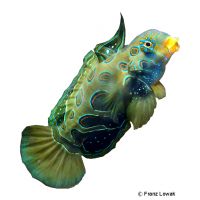Spotted Mandarinfish (Synchiropus picturatus)
| Spotted Mandarinfish Synchiropus picturatus | |
|---|---|
| Name | Spotted Mandarinfish |
| Name Lat. | Synchiropus picturatus |
| Family | Dragonets |
| Family lat. | Callionymidae |
| Order | Dragonets |
| Order lat. | Callionymiformes |
| Origin | Western Pacific |
| Habitat | Sandy areas, coral reefs |
| Diet | Carnivore |
| pH | 8.1-8.4 |
| Hardness | 8-10 °KH |
| Behavior | Peaceful |
| Keeping | Pair |
| Reef Compatible | Yes |
| Care Level | Difficult |
| Life Span | 2-5 years |
| Protection | No |
| Metric Units | |
| Size | 7 cm |
| Temperature | 24-28 °C |
| Salinity | 33-36 ‰ |
| Aquarium | ~ 200 l |
| US Units | |
| Size | 3" |
| Temperature | 75-82 °F |
| Salinity | 1.020-1.025 sg |
| Aquarium | ~ 50 gal |
Distribution and habitat
The distribution area of Synchiropus picturatus is the western Pacific Ocean, from the Philippines through New Guinea to the north coast of Australia. They live mostly in pairs in the sandy zones of shallow coral reefs protected from strong surf down to a depth of 20 m, where they are often burrowed to the upper half of their body.
Maintenance
They require a well-structured aquarium with a reef structure that allows for territoriality (crevices, caves, shelters) and free sandy areas with a not too fine, deep substrate. Only lime-rich, heavy metal-free substrates may be used as substrate.
To ensure water quality, filters, skimmers and heaters are necessary, as well as pumps to simulate tides, swells and bottom currents. It is recommended that live stones be used to set up the aquarium. The bacteria living in the porous stones act as a biological filter. The lighting must correspond to the species-appropriate day-night rhythm of the animals
| Salinity: 33-36 ‰ | pH value: 8.1-8.4 |
| Carbonate hardness: 8-10 °KH | Nitrate content: 2-8 mg/l |
| phosphate content: 0.01-0.1 mg/l | nitrite content: 0.0-0.05 mg/l |
For salinity, an average value should be aimed for, which may only vary slightly by +/- 0.5 ‰. Ammonia and ammonium must not be measurable. Special attention must be paid to constantly good water quality.
Diet
In nature, they feed mainly on small creatures found on the bottom, such as crustaceans or worms. The food change does not always succeed without problems. The food supply should consist of a combination of live and frozen food, such as small mysis, artemia, sand shrimp, bosmids and cyclops, with chopped shrimp, fish and mussel meat or a commercially available vitamin-enriched frozen food mix. Dry food (flakes, granules) is rarely accepted
It is recommended to feed small portions several times a day. Regular and varied feeding promotes health and increases resistance.
Behaviour and compatibility
They should be kept in pairs. They behave very territorial within their genus. Therefore, keeping a harem or several pairs of even different lyrefish is only possible in a larger and richly structured tank. They behave peacefully towards other fish.
Sex dimorphism
The male is slightly larger and more strongly colored, and his dorsal and caudal fins are slightly more developed than those of the female.
Reproduction and breeding
Breeding in the aquarium has already succeeded occasionally.
Important
Well-run coral aquariums with abundant small fauna provide optimal conditions for keeping them. The scaleless skin of these bottom-dwelling fish is protected by a thick, malodorous slime layer. Competition from fast eating fish should be avoided.
As coral reef dwellers, they should not be maintained in a fish-only aquarium
If different species are kept together, care should be taken to ensure that the fish match each other in terms of water quality and temperature requirements and social behavior, and that the setup meets the needs of all species kept together. New fish to be introduced must be acclimated slowly to the water in the aquarium.
Further literature can be found in your pet store.
References
Text: Werner Winter; Image: Franz Lowak
Source: KUITER, DEBELIUS (2007): Atlas der Meeresfische: Die Fische an den Küsten der Weltmeere, Kosmos Verlag; BAENSCH & DEBELIUS (2006): Meerwasser Atlas Bd. 1, Mergus Verlag; ENGELMANN (2005): Zootierhaltung - Tiere in menschlicher Obhut: Fische, Verlag Harri Deutsch
- Gemäß § 21 Abs. 5 Tierschutzgesetz idgF
